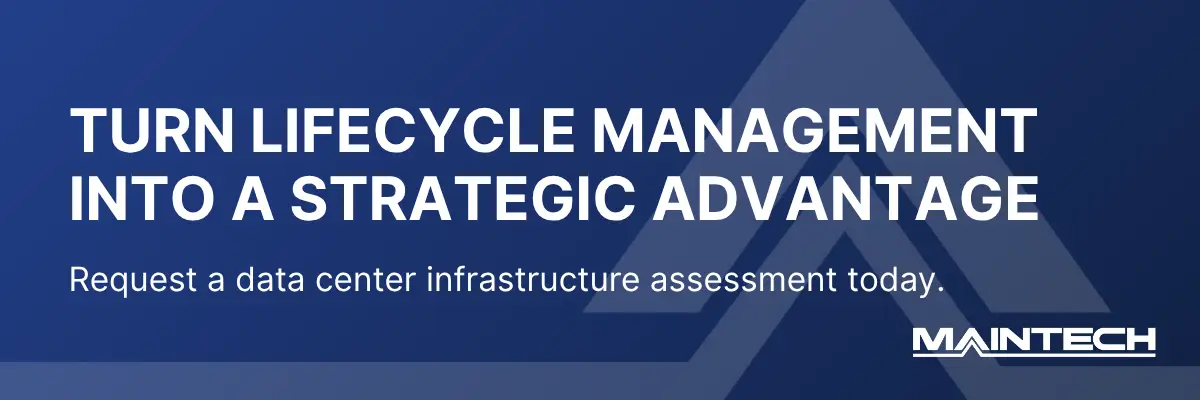Enterprise IT leaders often inherit a costly assumption: that data center infrastructure must be replaced strictly according to OEM timelines. For global operations managing thousands of assets, those refresh cycles can drain capital budgets, disrupt stability, and accelerate e-waste.
But modern data center infrastructure support strategies tell a different story. With the right intelligence, maintenance discipline, and lifecycle visibility, hardware can safely deliver peak performance years beyond its expected lifespan. That means deferred CapEx, extended ROI, and improved operational resilience.
For more than five decades, Maintech has helped Fortune 500 enterprises achieve exactly that, transforming refresh schedules into strategic assets through advanced data center lifecycle management, proactive maintenance, and vendor-neutral engineering.
This framework outlines how lifecycle extension strengthens financial efficiency, sustainability, and uptime – and how Maintech’s proven methodology enables enterprise IT teams to modernize smarter.
Why Lifecycle Extension Matters
In enterprise IT, hardware replacement cycles have long been dictated by the manufacturer’s end-of-life (EOL) schedules, regardless of whether or not the equipment had actually reached its EOL. For many organizations, that approach no longer aligns with financial reality or sustainability goals. Extending infrastructure lifespan through intelligent data center infrastructure helps you maximize the value from the investments you’ve already made.
Financial Impact
Every refresh cycle deferred represents millions in preserved capital. Lifecycle extension enables you to redirect that spend toward innovation projects, cloud adoption, or AI modernization instead of routine hardware swaps. By adopting structured data center lifecycle management practices, enterprises can smooth CapEx peaks, strengthen cash flow, and gain flexibility in long-term planning.
Sustainability and e-Waste Reduction
Continuing to operate viable hardware contributes directly to ESG objectives. Fewer hardware replacements mean lower manufacturing emissions, reduced electronic waste, and improved energy efficiency across data center ecosystems.
Business Continuity and Resilience
Replacing systems prematurely can introduce unnecessary risk and downtime, which can cost over $16,000 per minute for large businesses even during short outages. By maintaining proven systems under a structured legacy data center support model, IT leaders ensure operational stability even amid economic uncertainty or supply chain disruption.
When managed strategically, lifecycle extension is less of a stopgap and more of a deliberate evolution of enterprise infrastructure stewardship that balances performance, cost, and sustainability.
The 5-Phase Lifecycle Extension Framework
Maintech’s Lifecycle Extension Framework is designed to help enterprise IT leaders transform infrastructure maintenance from a reactive cost center into a strategic performance discipline. It’s a proven model that blends technology, analytics, and global delivery to extend the usable life of mission-critical assets without compromising reliability or compliance.
Phase 1: Infrastructure Assessment & Health Scoring
Lifecycle optimization begins with visibility. Maintech’s engineers conduct comprehensive audits across compute, storage, and network environments, assessing utilization, performance, environmental conditions, and mean time between failures.
Using predictive analytics and proprietary scoring tools, each asset is rated for health, risk, and longevity potential. This process forms the foundation for intelligent decision-making, identifying which systems can be confidently extended and which require proactive intervention. The result is a clear roadmap for IT asset lifecycle optimization that aligns engineering insight with executive priorities.
Phase 2: Proactive Maintenance Planning
Extending lifespan safely depends on discipline, not chance. We help clients transition from reactive fixes to predictive maintenance through telemetry monitoring, component-level analytics, and AI-driven performance alerts.
These insights inform detailed maintenance calendars that anticipate wear before it becomes failure. Scheduling service windows in advance keeps uptime consistent while reducing emergency costs. This approach reflects the essence of data center maintenance best practices: maintenance that prevents, not repairs.
Each plan also includes component refresh prioritization, allowing IT teams to replace high-risk parts without full system retirement, a key advantage for enterprises balancing uptime with budget constraints.
Phase 3: Vendor-Neutral Parts Sourcing
Our global sourcing network gives you flexibility beyond OEM supply chains. By leveraging certified refurbished components and pre-qualified suppliers, organizations reduce lead times, maintain SLA compliance, and lower total ownership costs, all while meeting the same quality assurance standards required by the manufacturer.
Comprehensive QA protocols, serial-number tracking, and failure-pattern analytics ensure reliability and traceability at every step. This vendor-agnostic strategy enhances resilience, especially when OEMs discontinue product lines or impose restrictive support contracts – a crucial advantage in legacy data center support.
Phase 4: Strategic Refresh vs Replace Decisions
The core of lifecycle extension lies in knowing when to act. Using asset-level health scores and performance data, Maintech supports CIOs with data-driven infrastructure refresh strategy recommendations.
Each system is evaluated through a cost-benefit lens that weighs maintenance expenditure, risk, and operational impact. Rather than defaulting to wholesale upgrades, we often guide hybrid modernization, selectively introducing new technology where it adds measurable value while maintaining proven systems that continue to meet SLA and compliance requirements.
Phase 5: Continuous Monitoring & Optimization
Lifecycle management doesn’t end with the plan; it evolves. We provide continuous performance tracking through intelligent monitoring platforms that detect anomalies early and recommend corrective action automatically.
These systems gather environmental telemetry, thermal data, and utilization trends to support predictive modeling. Insights flow into executive dashboards that provide real-time visibility into global asset health, ensuring decisions remain data-driven throughout the lifecycle.
This continuous feedback loop enables early intervention, prevents downtime, and drives sustained operational efficiency, the hallmarks of modern data center lifecycle management and world-class data center infrastructure support.
Real-World Application
Imagine a global financial institution managing thousands of assets across multiple data centers. OEM end-of-life dates are fast approaching, capital budgets are tightening, and leadership faces a difficult choice: replace hardware on schedule or explore lifecycle extension through a structured data center infrastructure support strategy.
The Approach
In this scenario, Maintech’s five-phase framework would begin with a detailed infrastructure assessment. Asset health scoring could reveal that a significant portion of systems still perform well within operational thresholds, allowing the business to safely extend usage by three to five years under a proactive maintenance plan.
Through continuous monitoring, predictive service scheduling, and vendor-neutral parts sourcing, they could maintain optimal uptime while reducing reliance on manufacturer timelines. A phased infrastructure refresh strategy would ensure critical systems receive targeted upgrades without large-scale disruption to operations or compliance.
The Potential Outcomes
By applying this model, the enterprise could:
- Maintain uptime rates through proactive maintenance.
- Defer millions in capital spend while reducing total cost of ownership.
- Advance ESG commitments through reduced e-waste and energy-efficient operations.
- Strengthen long-term agility by reallocating funds to digital transformation initiatives.
The Lesson
While every environment differs, this demonstrates the strategic advantage of structured data center lifecycle management. With the right methodology and partner, extending infrastructure lifespan is a controlled, data-driven opportunity to maximize ROI and resilience.
Turn Lifecycle Management into a Strategic Advantage
By rethinking refresh cycles and focusing on proactive data center infrastructure support, you can unlock years of additional performance from existing assets while preserving capital for innovation.
Our proven approach to data center lifecycle management helps enterprises move beyond manufacturer-driven refresh schedules toward data-driven decision-making. With over five decades of experience supporting Fortune 500 environments, we combine technical depth, global reach, and intelligent maintenance frameworks to keep mission-critical systems running at peak performance.
If your team is exploring how to defer CapEx without compromising uptime or compliance, now is the time to act. Request a data center infrastructure assessment today and discover how Maintech can help you extend value, reduce risk, and modernize smarter.
How long can data center infrastructure be safely extended?
With proactive maintenance and health scoring, most enterprise-grade systems can safely operate three to seven years beyond OEM timelines without affecting reliability.
What are the risks of extending infrastructure lifespan?
Risks mainly arise from inadequate monitoring or unsupported hardware. Structured maintenance and predictive analytics mitigate these issues effectively.
Is vendor-neutral maintenance as reliable as OEM support?
Yes. Certified parts, rigorous quality assurance, and experienced engineers ensure vendor-neutral solutions meet or exceed OEM reliability standards.
How do you determine when to refresh vs replace?
Decisions are guided by asset health scores, risk modeling, and performance data, ensuring every refresh delivers measurable ROI.


